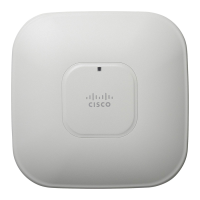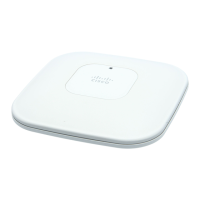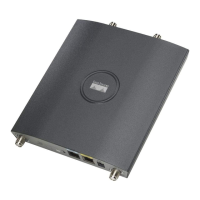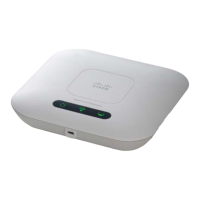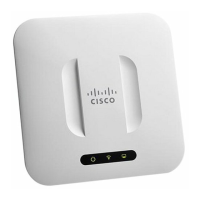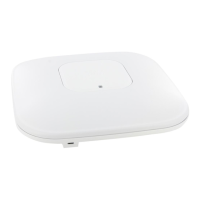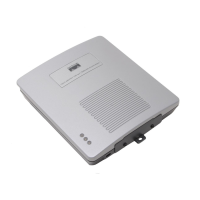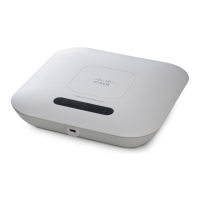Do you have a question about the Cisco Linksys WAP610N and is the answer not in the manual?
Explains the meaning of icons used in the guide for user attention.
Lists useful website addresses for support and additional information.
Details copyright and trademark information for Linksys and Cisco.
Describes the function and status of the Access Point's LED indicators.
Details the different ports available on the Access Point and their connections.
Guide on changing the default wireless network name (SSID) for better security.
Instructions on changing the default administrator password for security.
Explains how to enable MAC address filtering to control device access.
Details on enabling wireless encryption methods like WPA/WPA2 for data protection.
Provides general guidelines for securing the overall network environment.
Offers extra tips for enhancing wireless network security and placement.
Step-by-step instructions on accessing the device's web-based configuration interface.
Configuration settings for language and basic network parameters.
Option to select the display language for the browser-based utility.
Configuration for obtaining IP addresses via DHCP or static assignment.
Configure essential wireless network settings like SSID, band, and channel.
Manual configuration of wireless network parameters.
Selects the operating frequency band (2.4 GHz or 5.0 GHz).
Sets the unique name for the wireless network.
Configures channel width for optimal wireless performance.
Selects the primary channel for 40MHz channel width.
Selects the secondary channel for 40MHz or primary for 20MHz.
Controls whether the network name is broadcast to clients.
Configure security methods like WPA Personal, WPA2, WEP.
Selects the wireless security protocol (e.g., WPA2 Personal).
Configuration for WPA Personal security with TKIP encryption.
Sets the pre-shared key for WPA/WPA2 security.
Sets the interval for changing encryption keys automatically.
Configuration for WPA2 Personal security with TKIP/AES.
Configuration for WPA Enterprise security using a RADIUS server.
Configuration for WPA2 Enterprise security with a RADIUS server.
Configuration for the less secure WEP encryption standard.
Describes the Wi-Fi Protected Setup feature for easy wireless connection.
Configuration options for Wi-Fi Protected Setup.
Filters wireless access based on device MAC addresses.
Manages the list of MAC addresses allowed or blocked.
Displays connected wireless devices and their status.
Configures Wireless MultiMedia (WMM) settings for QoS.
Detailed settings for WMM access modes (Background, Best Effort, Video, Voice).
WMM settings for background traffic optimization.
WMM settings for best effort traffic optimization.
WMM settings for video traffic optimization.
WMM settings for voice traffic optimization.
Configure advanced wireless parameters like AP Isolation and Authentication.
Isolates wireless clients from each other for enhanced security.
Configures authentication methods for WEP security.
Sets the basic transmission rates advertised by the Access Point.
Configures data transmission speeds for different network modes.
Adjusts the transmit power percentage for wireless signals.
Enables CTS mode to improve performance in busy environments.
Sets the interval for broadcasting network beacons.
Sets the interval for Delivery Traffic Indication Message.
Adjusts the RTS threshold for data flow consistency.
Manage Access Point functions: backup, restore, and reboot.
Security settings for accessing the Access Point's interface.
Controls access to the browser utility via wired or wireless connection.
Restores the Access Point to its original factory default settings.
Instructions for upgrading the Access Point's firmware.
Displays current status information about the Access Point.
Shows firmware version and hardware details.
Details about the local network configuration (IP, MAC, Gateway).
Information about the current wireless network status.
Displays information about the browser-based utility.
Information about the utility's web server.
Steps to resolve issues with wireless connectivity.
Guide on setting a static IP address for the Access Point.
Solutions for password issues, including factory reset.
Model, standards, LEDs, ports, buttons, cabling, and antenna details.
Modulation, RF power, receive sensitivity, and antenna gain details.
Wireless security protocols and operating system requirements.
Dimensions, weight, power, certification, and environmental conditions.
Details the warranty period and coverage for the hardware product.
Lists conditions that void the warranty and its limitations.
Instructions on how to get technical support and warranty service.
Information on how to access technical support offerings.
Compliance statement regarding FCC rules for radio frequency devices.
Information on compliance with FCC limits for radio frequency exposure.
Important safety warnings regarding product usage and potential hazards.
Compliance statement for Industry Canada regulations.
Information on compliance with IC radiation exposure limits.
Details restrictions for operating in the 5 GHz frequency band.
Disclaimer regarding actual wireless performance variations.
Environmental information for EU customers regarding WEEE directive.
Information about software included with Cisco products.
Details on where to find applicable software license agreements.
The primary license agreement for Cisco software.
Outlines limitations on the use and distribution of the software.
Clarifies ownership of the software and documentation.
Cisco's disclaimer regarding third-party services and links.
Explains Cisco's policies on collecting and processing user data.
Information on software upgrades and browser setting changes.
Conditions for the termination of the software license agreement.
Warranty details for the software media provided by Cisco.
Limits Cisco's liability for damages related to software use.
Information on obtaining technical support for the software.
Compliance with US export control laws for software.
Specific terms for US government use of the software.
General legal terms and governing law for the agreement.
Specific license terms for Network Magic software features.
Restrictions on installing and executing Network Magic.
Terms related to subscription licenses for Network Magic.
Licenses for open source and third-party software components.
The GNU General Public License terms for open source software.
Explains the purpose and philosophy behind the GNU GPL.
Defines the conditions for copying, distributing, and modifying GPL software.
Scope and applicability of the GNU GPL.
Rules for copying and distributing verbatim GPL source code.
Conditions for modifying and distributing GPL-licensed works.
Terms for distributing GPL programs in object code or executable form.
Explains how works that use the Library are covered.
Exception for combining Library works with other code.
Conditions for distributing combined libraries.
Prohibitions on copying, modifying, or distributing the Library.
Acceptance of the License by modifying or distributing the Library.
Recipient's rights when the Library is redistributed.
What to do if patent infringement conditions contradict the license.
Geographical distribution limitations for the Library.
Information on new versions of the GNU GPL.
Permission to incorporate GPL parts into other programs.
Disclaimer of warranty for the free software.
Explicit warranty disclaimer for the program.
Limits Cisco's liability for damages from program use.
The GNU Lesser General Public License terms.
Explains the purpose of the GNU LGPL.
Conditions for copying, distributing, and modifying LGPL libraries.
Scope and applicability of the GNU LGPL.
Rules for copying and distributing verbatim LGPL source code.
Conditions for modifying and distributing LGPL library works.
Option to apply the standard GPL instead of LGPL.
Terms for distributing LGPL libraries in object code or executable form.
Required acknowledgement for software using Eric Young's code.
Warranty disclaimer for software provided by Eric Young.
Explains the meaning of icons used in the guide for user attention.
Lists useful website addresses for support and additional information.
Details copyright and trademark information for Linksys and Cisco.
Describes the function and status of the Access Point's LED indicators.
Details the different ports available on the Access Point and their connections.
Guide on changing the default wireless network name (SSID) for better security.
Instructions on changing the default administrator password for security.
Explains how to enable MAC address filtering to control device access.
Details on enabling wireless encryption methods like WPA/WPA2 for data protection.
Provides general guidelines for securing the overall network environment.
Offers extra tips for enhancing wireless network security and placement.
Step-by-step instructions on accessing the device's web-based configuration interface.
Configuration settings for language and basic network parameters.
Option to select the display language for the browser-based utility.
Configuration for obtaining IP addresses via DHCP or static assignment.
Configure essential wireless network settings like SSID, band, and channel.
Manual configuration of wireless network parameters.
Selects the operating frequency band (2.4 GHz or 5.0 GHz).
Sets the unique name for the wireless network.
Configures channel width for optimal wireless performance.
Selects the primary channel for 40MHz channel width.
Selects the secondary channel for 40MHz or primary for 20MHz.
Controls whether the network name is broadcast to clients.
Configure security methods like WPA Personal, WPA2, WEP.
Selects the wireless security protocol (e.g., WPA2 Personal).
Configuration for WPA Personal security with TKIP encryption.
Sets the pre-shared key for WPA/WPA2 security.
Sets the interval for changing encryption keys automatically.
Configuration for WPA2 Personal security with TKIP/AES.
Configuration for WPA Enterprise security using a RADIUS server.
Configuration for WPA2 Enterprise security with a RADIUS server.
Configuration for the less secure WEP encryption standard.
Describes the Wi-Fi Protected Setup feature for easy wireless connection.
Configuration options for Wi-Fi Protected Setup.
Filters wireless access based on device MAC addresses.
Manages the list of MAC addresses allowed or blocked.
Displays connected wireless devices and their status.
Configures Wireless MultiMedia (WMM) settings for QoS.
Detailed settings for WMM access modes (Background, Best Effort, Video, Voice).
WMM settings for background traffic optimization.
WMM settings for best effort traffic optimization.
WMM settings for video traffic optimization.
WMM settings for voice traffic optimization.
Configure advanced wireless parameters like AP Isolation and Authentication.
Isolates wireless clients from each other for enhanced security.
Configures authentication methods for WEP security.
Sets the basic transmission rates advertised by the Access Point.
Configures data transmission speeds for different network modes.
Adjusts the transmit power percentage for wireless signals.
Enables CTS mode to improve performance in busy environments.
Sets the interval for broadcasting network beacons.
Sets the interval for Delivery Traffic Indication Message.
Adjusts the RTS threshold for data flow consistency.
Manage Access Point functions: backup, restore, and reboot.
Security settings for accessing the Access Point's interface.
Controls access to the browser utility via wired or wireless connection.
Restores the Access Point to its original factory default settings.
Instructions for upgrading the Access Point's firmware.
Displays current status information about the Access Point.
Shows firmware version and hardware details.
Details about the local network configuration (IP, MAC, Gateway).
Information about the current wireless network status.
Displays information about the browser-based utility.
Information about the utility's web server.
Steps to resolve issues with wireless connectivity.
Guide on setting a static IP address for the Access Point.
Solutions for password issues, including factory reset.
Model, standards, LEDs, ports, buttons, cabling, and antenna details.
Modulation, RF power, receive sensitivity, and antenna gain details.
Wireless security protocols and operating system requirements.
Dimensions, weight, power, certification, and environmental conditions.
Details the warranty period and coverage for the hardware product.
Lists conditions that void the warranty and its limitations.
Instructions on how to get technical support and warranty service.
Information on how to access technical support offerings.
Compliance statement regarding FCC rules for radio frequency devices.
Information on compliance with FCC limits for radio frequency exposure.
Important safety warnings regarding product usage and potential hazards.
Compliance statement for Industry Canada regulations.
Information on compliance with IC radiation exposure limits.
Details restrictions for operating in the 5 GHz frequency band.
Disclaimer regarding actual wireless performance variations.
Environmental information for EU customers regarding WEEE directive.
Information about software included with Cisco products.
Details on where to find applicable software license agreements.
The primary license agreement for Cisco software.
Outlines limitations on the use and distribution of the software.
Clarifies ownership of the software and documentation.
Cisco's disclaimer regarding third-party services and links.
Explains Cisco's policies on collecting and processing user data.
Information on software upgrades and browser setting changes.
Conditions for the termination of the software license agreement.
Warranty details for the software media provided by Cisco.
Limits Cisco's liability for damages related to software use.
Information on obtaining technical support for the software.
Compliance with US export control laws for software.
Specific terms for US government use of the software.
General legal terms and governing law for the agreement.
Specific license terms for Network Magic software features.
Restrictions on installing and executing Network Magic.
Terms related to subscription licenses for Network Magic.
Licenses for open source and third-party software components.
The GNU General Public License terms for open source software.
Explains the purpose and philosophy behind the GNU GPL.
Defines the conditions for copying, distributing, and modifying GPL software.
Scope and applicability of the GNU GPL.
Rules for copying and distributing verbatim GPL source code.
Conditions for modifying and distributing GPL-licensed works.
Terms for distributing GPL programs in object code or executable form.
Explains how works that use the Library are covered.
Exception for combining Library works with other code.
Conditions for distributing combined libraries.
Prohibitions on copying, modifying, or distributing the Library.
Acceptance of the License by modifying or distributing the Library.
Recipient's rights when the Library is redistributed.
What to do if patent infringement conditions contradict the license.
Geographical distribution limitations for the Library.
Information on new versions of the GNU GPL.
Permission to incorporate GPL parts into other programs.
Disclaimer of warranty for the free software.
Explicit warranty disclaimer for the program.
Limits Cisco's liability for damages from program use.
The GNU Lesser General Public License terms.
Explains the purpose of the GNU LGPL.
Conditions for copying, distributing, and modifying LGPL libraries.
Scope and applicability of the GNU LGPL.
Rules for copying and distributing verbatim LGPL source code.
Conditions for modifying and distributing LGPL library works.
Option to apply the standard GPL instead of LGPL.
Terms for distributing LGPL libraries in object code or executable form.
Required acknowledgement for software using Eric Young's code.
Warranty disclaimer for software provided by Eric Young.
| Model | WAP610N |
|---|---|
| Device Type | Wireless Access Point |
| Frequency Band | 2.4 GHz |
| Wireless Speed | Up to 300 Mbps |
| Wireless Standards | 802.11n |
| Ports | 1 x 10/100 Ethernet |
| Security | WPA2, WPA, WEP |
| Power | 12V DC |
| Weight | 0.66 lb (300 g) |
| Operating Temperature | 32 to 104°F (0 to 40°C) |
| Operating Humidity | 10% to 85% (non-condensing) |
| Antennas | 2 Internal Antennas |

